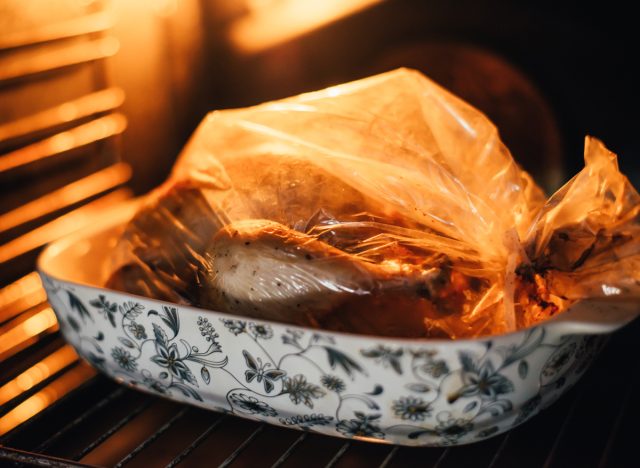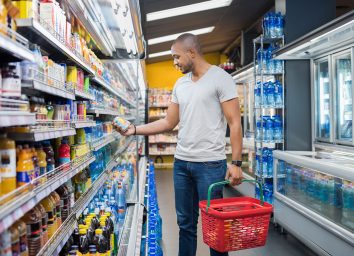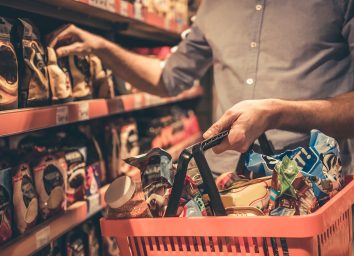This Popular Cooking Hack Can Actually Release Trillions of Plastic Nanoparticles Into Your Food, Study Finds

The iconic pop song "Barbie Girl" by Aqua tells us that "life in plastic, it's fantastic," but it's safe to say most real-life humans would disagree. Unfortunately, we're quickly filling our planet, and ourselves, with more and more plastic.
The first synthetic plastic was only developed 115 years ago in 1907. Since then, humanity has been producing ever-increasing amounts of plastic and using it for pretty much everything and anything. The year 1950 saw only two million tons of plastic produced. Fast forward to 2019, and that figure jumps to an astounding 368 million tons!
Making matters even more wasteful is the fact that plastic products are hardly useful over the long term. It's estimated that about 40% of all plastics are used for nothing more than packaging and discarded within a single month. Plastic isn't biodegradable either, which means pieces of plastic trash left in forests, on sidewalks, and drifting in the ocean aren't going anywhere anytime soon. Eventually, those big pieces of plastic break down into smaller bits, spreading out and further polluting surrounding areas.
The problem of environmental plastic pollution is a well-documented one, but did you know that your own body is being bombarded with plastics as well? According to one recent study, the average modern adult ingests around 39,000 to 52,000 microplastic particles per year.
These tiny microplastic particles, and even smaller plastic nanoparticles, can make their way into the human body via a variety of sources. Seafood, table salt, both tap, and bottled water, and even the very air in your home, are just a few avenues by which plastics enter our bodies.
Now, noteworthy new research just published in the scientific journal Environmental Science & Technology has discovered yet another possible source of covert plastic ingestion that had largely gone unnoticed up until now. Keep reading to learn more!
Nylon cooking bags, plastic cups, and trillions of nanoparticles

Study authors from the American Chemical Society report that the plastics found in both nylon cooking bags and plastic-lined cardboard cups release trillions of nanoparticles into each liter of water they touch.
A nylon cooking bag can make life in the kitchen much easier. Great for keeping food moist in the oven or simplifying slow-cooker recipes, countless chefs rely on food-grade nylons.
Similarly, plastic-lined cups, usually designed for one-time use, are super handy when you need some java on the go. The plastic covering the cups keeps your coffee hot while simultaneously stopping potentially messy leaks.
These culinary hacks are certainly convenient, but are they worth potentially ingesting countless plastic nanoparticles? To start, let's get a better sense of how truly tiny these nanoparticles are:
"In our study we measured nanoplastics that are smaller than 100 nm (nanometer) from materials that are very common. For reference of size of these particles, 1000 particles with a diameter of 100 nm can fit across a human hair. So, these are very small particles," says lead study author, Dr. Christopher D. Zangmeister.
Safe by FDA standards
Many will probably feel unsure about using these products in the future. But, believe it or not, the mystifying truth is that the FDA says trillions of nanoparticles are A-OK for human consumption.
"The FDA measures the release of materials in contact with food and beverages by mass, independent of the state of that material. The released material could be a dissolved small molecular polymer chain that makes up the plastic backbone or a plastic particle," Zangmeister explains.
"The released materials were below the mass limit set by the FDA for food-grade nylon, and we don't know if the state of the released material influences how it affects the health of the person consuming the food or beverage," he continues.
The uncomfortable truth is that there is still so much we don't know about nanoparticles released from plastics. The potential health implications for humans are largely a mystery. These nanoparticles are theoretically small enough to enter our cells, potentially impacting cellular functioning—but this has yet to be confirmed.
The experiment
Both room temperature and hot water were poured into some low-density polyethylene-lined cardboard cups and nylon slow cooker bags (from various retailers).
When the slow cooker was kept hot for a full hour, 35 trillion plastic nanoparticles dispersed into the liter of water in each bag. Similarly, when hot water was poured into 12-fluid-ounce cups for just 20 minutes, 5.1 trillion plastic nanoparticles "leached" out per liter.
Room temperature water led to the release of nanoparticles as well, but not nearly as many.
According to the research team's calculations, a person would have to drink 13 cups of hot water from a plastic-lined cup to ingest the equivalent of one nanoplastic particle for every seven cells in their body. Consuming half a liter of hot water from a cooking bag would have the same effect.
Moreover, nylon bags and disposable coffee cups are far from the only sources of plastic-released nanoparticles.
"We focused on food-grade nylon and nanoplastics from single-use coffee cups, but we also studied other common materials as well. We detected similar particles in many other commonly used materials as well, such as plastic bags, plastic pipes, and containers," Zangmeister comments.
What's next?
For now, modern science is a long way from determining the health impact of these nanoparticles on humans upon ingestion. In fact, study authors concede we aren't even technically ready to tackle that big question just yet.
"Currently we're at the stage of trying to identify what materials release particles, their composition, size range, and concentrations in water. In parallel determine their role, if any, on human health. It will take a lot of additional work to understand their effect. Factors such as particle size and chemical composition may play a role," Zangmeister says.
Don't concern yourself with avoiding plastic nanoparticles entirely. It's a fool's errand. We're literally surrounded by plastic all the time. Nanoplastics are even present in the majority of the world's drinking water. These findings are a smaller piece of a much larger puzzle….that's probably made of plastic.
"Like I said, we're still at the early stages in answering these questions. It is important to understand that many of these materials that we haven't given a second thought to; common consumer-grade materials that contact our food and beverages, may release plastics that are easily consumed," Zangmeister concludes.









